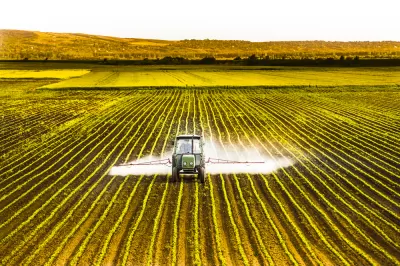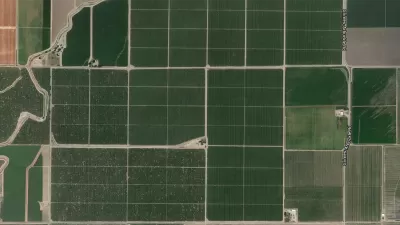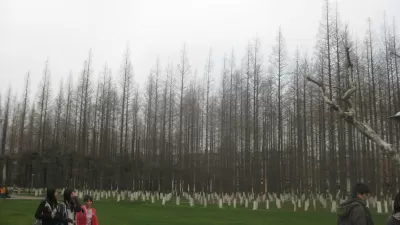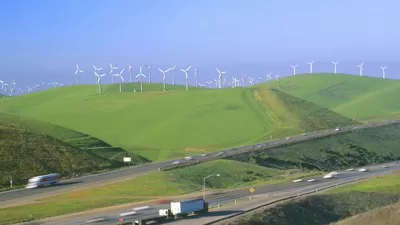Not urban land use, but in the literal sense: land used to produce food, graze livestock, supply drinking water, grow trees, and sequester carbon. As the climate warms and the population grows, crop yields will decrease and land will be degraded.

The Special Report on Climate Change and Land, released in summary form last Thursday, August 8, was written by 107 experts from 52 countries for the Intergovernmental Panel on Climate Change (IPCC), the United Nations body for assessing the science related to climate change. It is unlike most other climate change reports in that its primary focus is not fossil fuel consumption, the primary source of human-caused greenhouse gas emissions, but land management.
Agriculture, food production, and deforestation are major drivers of climate change, accounting for an estimated 23% of total anthropogenic greenhouse gas emissions from 2007-2016. And while greenhouse gas emissions are central to any climate change report, this 'special report' looks at other critical factors, particularly the ability of the planet to feed itself.
"This is the first time in IPCC report history that a majority of authors – 53% – are from developing countries,” said Hoesung Lee, Chair of the IPCC, in a statement.
Brady Dennis, who focuses on the environment and public health issues for The Washington Post, writes (in the source article):
The world cannot avoid the worst impacts of climate change without making serious changes to the ways humans grow food, raise livestock and manage forests, according to a landmark study Thursday [Aug. 8] from an international group of scientists.
The report "details how climate change is already threatening food and water supplies for humans: turning arable land to desert [desertification]; degrading soil; and increasing the threat of droughts, floods and other extreme weather that can wreak havoc on crops."
What about planting a trillion trees?
"Planting as many trees as possible would reduce the amount of greenhouse gases in the atmosphere by about nine gigatons each year, according to Pamela McElwee, a professor of human ecology at Rutgers University and one of the report’s lead authors," reports Christopher Flavelle, who covers climate adaptation for The New York Times
But it would also increase food prices as much as 80 percent by 2050 by pushing crops and livestock onto less productive land, explains Flavelle.
“We cannot plant trees to get ourselves out of the problem that we’re in,” Dr. McElwee said. “The trade-offs that would keep us below 1.5 degrees, we’re not talking about them. We’re not ready to confront them yet.”
However, the report notes that "forests and farms play a key role as 'carbon sinks' that remove greenhouse gases from the atmosphere, but that benefit will continue only if humans use land in sustainable ways," adds Dennis. And that's the essence of this special report – sustainable land management.
Food security
"A particular danger is that food crises could develop on several continents at once, said Cynthia Rosenzweig, a senior research scientist at the NASA Goddard Institute for Space Studies and one of the lead authors of the report," adds Flavelle. “The potential risk of multi-breadbasket failure is increasing."
The report also offered a measure of hope, laying out pathways to addressing the looming food crisis, though they would require a major re-evaluation of land use and agriculture worldwide as well as consumer behavior.
Proposals include increasing the productivity of land, wasting less food and persuading more people to shift their diets away from cattle and other types of meat.
Energy production
While fossil fuel extraction is not covered in the special report, bioenergy is considered from several perspectives. Growing corn to produce ethanol reduces the food supply and also "could lead to the creation of new deserts or other land degradation, the authors said," adds Flavelle.
"The report said that activities such as draining wetlands — as has happened in Indonesia and Malaysia to create palm oil plantations, for example — is particularly damaging," notes Dennis. At the same time, the report acknowledges that biofuels are necessary to reduce fossil fuels, but land use must be a consideration.
Human population growth
The IPCC press release recognizes the advantages of lower population growth, along with other factors that would increase sustainability as the planet warms:
An overall focus on sustainability coupled with early action offers the best chances to tackle climate change. This would entail low population growth and reduced inequalities, improved nutrition and lower food waste.
But the authors don't appear to take a position on population growth in the same way that they address land use issues. Rather, the point of the report is to show how better land management will accommodate the needs of a growing human population while the climate warms. However, it's important to recognize that it's not just the number of humans that factors into the equation, as chapter one indicates:
Human population is projected to increase to nearly 9.8 (± 1) billion people by 2050 and 11.2 billion by 2100 (United Nations 2018). More people, a growing global middle class (Crist et al. 2017), economic growth, and continued urbanisation (Jiang and O’Neill 2017) increase the pressures on expanding crop and pasture area and intensifying land management...Changes in diets, efficiency and technology could reduce these pressures...
The authors did address the dispersion of the population, i.e., international migration, as Flavelle reported.
Some authors also suggested that food shortages are likely to affect poorer parts of the world far more than richer ones. That could increase a flow of immigration that is already redefining politics in North America, Europe and other parts of the world.
“People’s lives will be affected by a massive pressure for migration,” said Pete Smith, a professor of plant and soil science at the University of Aberdeen [Scotland] and one of the report’s lead authors. “People don’t stay and die where they are. People migrate.”
Related in Planetizen:
-
To Solve Climate Change: Plant a Trillion Trees, July 8, 2019
-
Study: Agriculture's Carbon Output Higher Than Previously Thought, September 12, 2017
-
Desertification Threatens 38% of World's Surface, February 11, 2010
-
Global Warming Could Increase Deserts 34% in Next Century, August 20, 2009
-
Seizing Cattle to Fight Deforestation, June 28, 2008
FULL STORY: Changing climate imperils global food and water supplies, new U.N. study finds

Study: Maui’s Plan to Convert Vacation Rentals to Long-Term Housing Could Cause Nearly $1 Billion Economic Loss
The plan would reduce visitor accommodation by 25,% resulting in 1,900 jobs lost.

Alabama: Trump Terminates Settlements for Black Communities Harmed By Raw Sewage
Trump deemed the landmark civil rights agreement “illegal DEI and environmental justice policy.”

Why Should We Subsidize Public Transportation?
Many public transit agencies face financial stress due to rising costs, declining fare revenue, and declining subsidies. Transit advocates must provide a strong business case for increasing public transit funding.

Paris Bike Boom Leads to Steep Drop in Air Pollution
The French city’s air quality has improved dramatically in the past 20 years, coinciding with a growth in cycling.

Why Housing Costs More to Build in California Than in Texas
Hard costs like labor and materials combined with ‘soft’ costs such as permitting make building in the San Francisco Bay Area almost three times as costly as in Texas cities.

San Diego County Sees a Rise in Urban Coyotes
San Diego County experiences a rise in urban coyotes, as sightings become prevalent throughout its urban neighbourhoods and surrounding areas.
Urban Design for Planners 1: Software Tools
This six-course series explores essential urban design concepts using open source software and equips planners with the tools they need to participate fully in the urban design process.
Planning for Universal Design
Learn the tools for implementing Universal Design in planning regulations.
Smith Gee Studio
Alamo Area Metropolitan Planning Organization
City of Santa Clarita
Institute for Housing and Urban Development Studies (IHS)
City of Grandview
Harvard GSD Executive Education
Toledo-Lucas County Plan Commissions
Salt Lake City
NYU Wagner Graduate School of Public Service





























